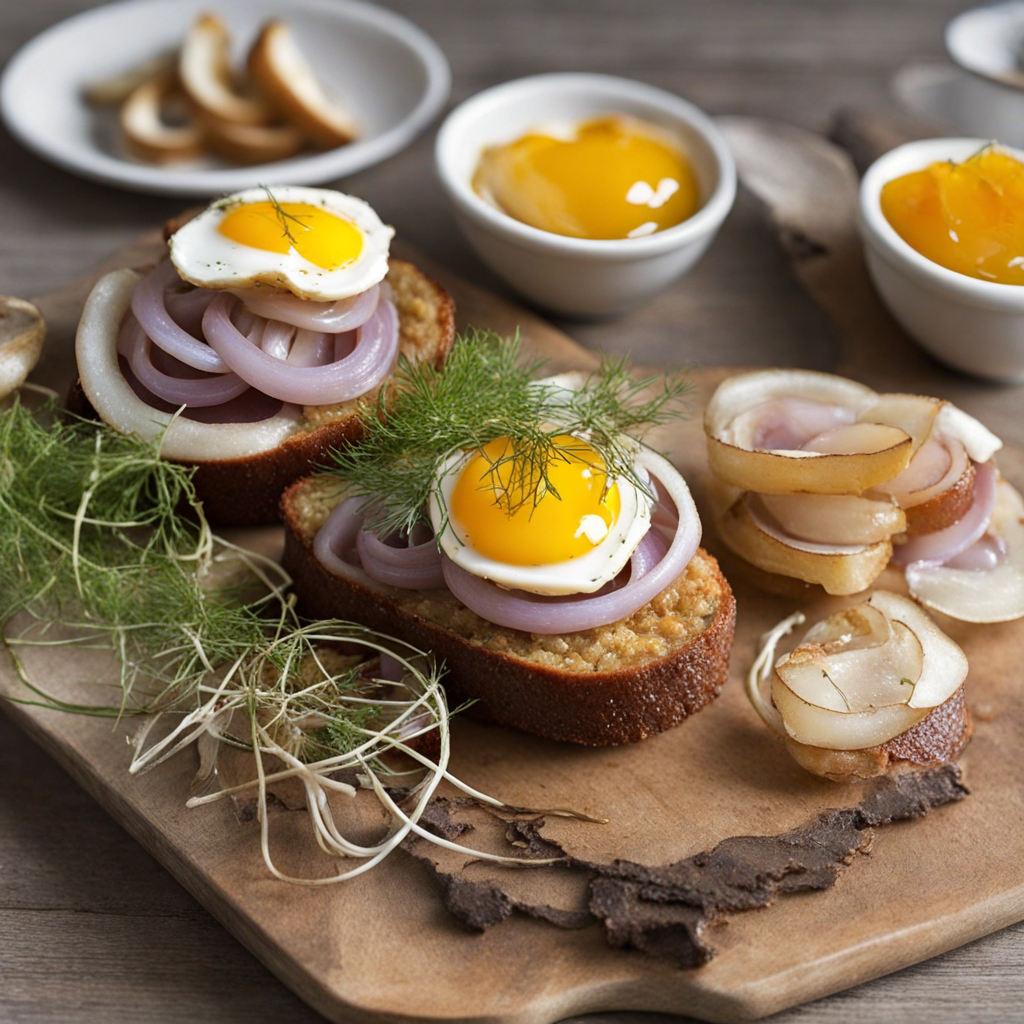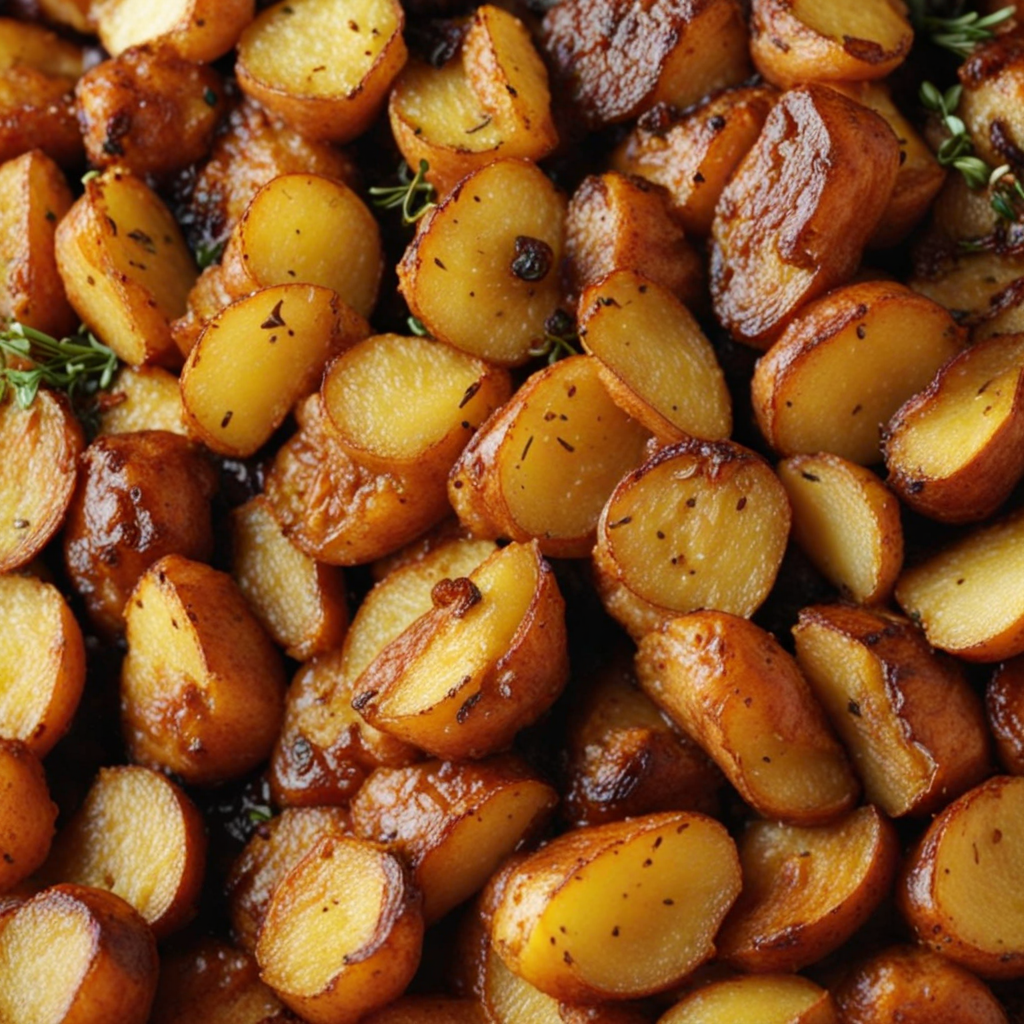Sol over Gudhjem
Sol over Gudhjem is a delightful Danish dish that beautifully showcases the region's culinary heritage. The name translates to "Sun over Gudhjem," referring to the picturesque town on the island of Bornholm, known for its stunning landscapes and fresh ingredients. This dish typically features a slice of dark rye bread as its base, topped with a generous layer of rich, creamy smoked herring, which imparts a robust flavor profile reminiscent of the sea. The combination of textures—from the crusty bread to the velvety fish—creates a satisfying mouthfeel that is truly unique. To elevate the experience, Sol over Gudhjem is often garnished with a soft-boiled egg, which adds a luscious richness to each bite. The egg yolk, when broken, blends seamlessly with the smoky herring, creating a creamy sauce that enhances the overall dish. Traditional components such as finely chopped chives or onions add a touch of freshness and a slight crunch, while a sprinkle of freshly cracked black pepper introduces a hint of spice that balances the flavors beautifully. The dish is not only a feast for the palate but also a visual delight, with its vibrant colors and artful presentation. Serving Sol over Gudhjem can be a delightful ritual, often enjoyed as an open-faced sandwich during lunch or as an appetizer at gatherings. The combination of ingredients reflects the Danish ethos of utilizing local produce and seafood, creating a dish that is both wholesome and indulgent. Whether you are a seasoned gourmet or a curious food lover, indulging in Sol over Gudhjem offers a taste of Denmark that captures the essence of its coastal charm and culinary traditions.
How It Became This Dish
Sol Over Gudhjem: A Culinary Jewel of Denmark Origins of Sol over Gudhjem Sol over Gudhjem, which translates to "Sun over Gudhjem," is a traditional Danish open-faced sandwich (smørrebrød) that hails from the picturesque island of Bornholm, located in the Baltic Sea. This dish embodies the essence of Danish culinary tradition, focusing on simplicity, quality ingredients, and regional flavors. Its name poetically captures the visual appeal of the dish, which resembles the sun rising over the coastal town of Gudhjem. The origins of Sol over Gudhjem can be traced back to the late 19th and early 20th centuries, during a time when Danish cuisine was beginning to gain recognition beyond its borders. The island of Bornholm has a rich maritime heritage, and fishing has long been a vital part of the local economy and culture. Herring, in particular, played a crucial role, being plentiful in the region and a staple in the diets of the island's inhabitants. The dish itself typically consists of a slice of dense rye bread topped with cured herring, often served with a raw egg yolk, finely chopped onions, and fresh herbs. The herring, which is either pickled or smoked, provides a briny, rich flavor that is beautifully complemented by the creamy, unctuous egg yolk. The combination of textures and flavors creates a culinary experience that reflects the natural bounty of Bornholm. Cultural Significance Sol over Gudhjem is more than just a delicious sandwich; it is a symbol of Danish identity and culture, particularly for those from Bornholm. The dish represents the island's connection to the sea and its reliance on fishing and agriculture. The rye bread serves as a reminder of the traditional grains that have sustained Danes for centuries, while the herring showcases the importance of local seafood in Danish cuisine. In addition to its gastronomic significance, Sol over Gudhjem is often associated with the concept of "hygge," a Danish term that conveys a sense of coziness and contentment. Enjoying this dish, particularly in a picturesque setting overlooking the sea, evokes the natural beauty and tranquility of Bornholm. It is common to find Sol over Gudhjem served in local restaurants, particularly during the summer months when both tourists and locals flock to the island. The dish has also played a role in Denmark's broader culinary renaissance, which began in the late 20th century. As chefs and food enthusiasts sought to revive traditional recipes and ingredients, Sol over Gudhjem emerged as a cherished dish that exemplifies the best of Danish smørrebrød. Its popularity has grown beyond Bornholm, earning a place on menus throughout Denmark and even inspiring variations in other Scandinavian countries. Development Over Time The development of Sol over Gudhjem can be viewed through several phases, reflecting changes in Danish society, culinary practices, and the global food landscape. In the early days, the dish was primarily a local specialty, enjoyed by fishermen and their families as a hearty meal after long days at sea. Simple and nutritious, it provided the energy needed to sustain those who toiled on the waters of the Baltic. As Denmark began to experience industrialization and urbanization in the late 19th and early 20th centuries, culinary traditions began to evolve. The rise of the middle class and increased access to diverse ingredients allowed for greater experimentation in the kitchen. While the core elements of Sol over Gudhjem remained intact, variations began to emerge. While herring continues to be the star of the dish, other toppings such as radishes, capers, or even avocado have appeared in modern interpretations. The post-World War II era brought about significant changes in Danish cuisine as well. With the advent of globalization and increased travel, Denmark began to embrace international culinary trends. Chefs began to explore fusion cuisines, and Sol over Gudhjem found itself reimagined in a variety of ways. The dish began to appear in upscale restaurants and gourmet establishments, often presented with a contemporary twist. In the 21st century, Sol over Gudhjem has enjoyed a resurgence as part of the New Nordic Cuisine movement, which emphasizes the use of local, seasonal ingredients and traditional cooking methods. As chefs have sought to celebrate Denmark's culinary heritage, Sol over Gudhjem has been elevated to a dish worthy of fine dining. Some chefs experiment with different types of herring, incorporating flavors such as beetroot, dill, or citrus to create innovative versions that pay homage to the original while appealing to modern palates. Conclusion Sol over Gudhjem is more than just a culinary creation; it is a reflection of Denmark's rich maritime history, cultural identity, and evolving culinary practices. From its humble beginnings as a fisherman's meal on the shores of Bornholm to its place on the tables of fine dining restaurants, this open-faced sandwich tells a story of tradition, innovation, and a deep connection to the land and sea. As Denmark continues to embrace its culinary roots while exploring new flavors and techniques, Sol over Gudhjem remains a beloved dish that captures the essence of Danish cuisine. Whether enjoyed in a local café overlooking the Baltic Sea or served at a gourmet restaurant in Copenhagen, Sol over Gudhjem invites diners to savor the unique flavors of Denmark while celebrating the rich cultural heritage that has shaped this extraordinary dish. In its simplicity and elegance, Sol over Gudhjem stands as a testament to the timeless appeal of traditional Danish food, reminding us that sometimes, the most profound culinary experiences come from the most humble of beginnings.
You may like
Discover local flavors from Denmark







